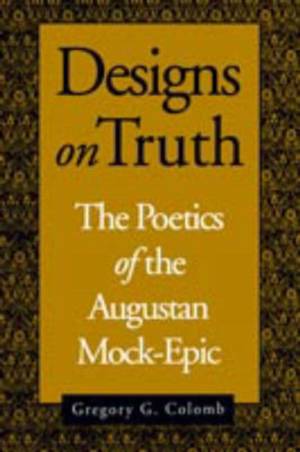
- Retrait gratuit dans votre magasin Club
- 7.000.000 titres dans notre catalogue
- Payer en toute sécurité
- Toujours un magasin près de chez vous
- Retrait gratuit dans votre magasin Club
- 7.000.0000 titres dans notre catalogue
- Payer en toute sécurité
- Toujours un magasin près de chez vous
Description
Designs on Truth provides a reinterpretation of Augustan poetry, not as works to be defended before the court of Matthew Arnold and the Romantic tradition but as works that examine the rich relationships among text, culture, and world.
In Designs on Truth, Gregory Colomb identifies the characteristics of the mock-epic and argues that the form had developed formal expectations. In making this argument, he explains the intentions of the writers of mock-epics, and expands our conception of the interest and significance of such poems. By demonstrating how these poems are supported by the genre's poetics, he brings out ways these poems differ from other "Augustan" poems such as the Horatian epistles that are often discussed with them.
Designs on Truth puts into question the distinction between history and poetry in the mock-epic, examining it at three levels of poetic structure: fable (global narrative structure), and portraits (characterological narrative structure). Focusing chiefly on the mock-epic's representations in terms of class and "kind," this study returns historical particulars to the central role that the poets had always given them and seeks to understand how they are made poetic. Designs on Truth shows how the poems themselves subvert any easy distinction between historical and poetic particulars. This often philosophical genre is itself a reconsideration of the role of reference (fact) and judgment (value) in representation.
This study shows how representation and judgment work in the mock-epic, and how together they stand at the heart of the dominant Augustan poetic. Colomb also provides new readings of the mock-epic, including the first comprehensive reading of The Dispensary since the eighteenth century.
Spécifications
Parties prenantes
- Auteur(s) :
- Editeur:
Contenu
- Nombre de pages :
- 256
- Langue:
- Anglais
Caractéristiques
- EAN:
- 9780271026275
- Date de parution :
- 15-04-92
- Format:
- Livre broché
- Format numérique:
- Trade paperback (VS)
- Dimensions :
- 164 mm x 229 mm
- Poids :
- 390 g

Les avis
Nous publions uniquement les avis qui respectent les conditions requises. Consultez nos conditions pour les avis.






